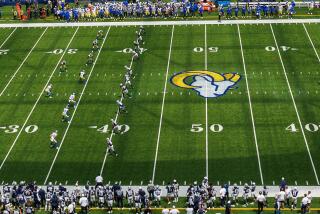WORLD CUP ’94 : Exposing the Offense
- Share via
Scoring to Win
To encourage higher-scoring games, teams will be awarded three points for a victory and one for a tie in the first round of World Cup play. In the past, teams received two points for a victory and one for a tie. With the old system, many teams stacked their defense and played for a tie. The revision of the point system, World Cup organizers hope, will encourage attacking play.
A. TACTICAL STRATEGY Numerous attack patterns will be executed during the World Cup. A common one involves the two strikers criss-crossing to confuse defenders and one wing overlapping the play while the other wing stays back. In this attack, the midfielder with the ball has at least four passing options or can dribble in and shoot.
B. CORNER KICK Three basic approaches are used.
1. A very short pass followed by a return pass to the kicker can be used for an attack along the end line. 2. The ball can be passed to the middle of the box, where attacking players try to head the ball into the net. The goalkeeper often will charge out and attempt to punch or catch the ball. 3. The ball can be passed to the top of the box for a shot through a maze of players in hopes that the goalie will be shielded.
C. FREE KICK Direct kicks near an opposing goal are executed in various ways. 1. Shots on goal must go around, through or over a wall of defenders 10 yards from the ball. 2. Because of the difficulty of a direct shot on goal, a pass to a nearby teammate with a clear shooting angle is often tried. * Indirect free kicks--Awarded for lesser fouls, must be touched by two players before going into the goal. * Free kicks--Far away from the goal, they usually result in a short pass that merely re-starts play.
BICYCLE KICK The signature play of Brazilian superstar Pele, the bicycle kick is a volley in which a player strikes the ball while it is over his head. Both of his feet are off the ground at the time of contact. 1. A player approaching a bicycle kick must be certain there are no other players nearby or he will be called for a dangerous play. 2. A player begins his leap by raising his non-kicking leg to achieve balance. 3. Using a pedaling motion, the player drives his other leg into the air to make contact with the ball. 4. A player lands with his back to the play.
KICKING THE BALL
* Chip shot--A high-arching shot made by hitting the bottom half of the ball without following through on the kick.
* Banana kick--A kick that bends or curves, its action determined by how and where the ball is struck. A. Inswinger--a corner kick that curves towards the net, is made by hitting the bottom outside quadrant of the ball with the inside part of the foot. B. Outswinger--a corner kick that curves away from the net, is made by hitting the bottom inside quadrant of the ball with the outside part of the foot.
* Power kick--A low-flying high-velocity kick made by hitting the center of the ball with the top part of the foot.
GLOSSARY * Far post; near post--The areas near the goalposts that are, respectively, further from and closest to where the ball is being played.
* Heel pass--A backward pass struck with a player’s heel.
* Own goal--A goal scored by a player against his own team.
* Overlap--The action by a defensive player moving into the attack, usually leaving another player to temporarily assume his defensive duties.
* Square ball--A lateral pass; also referred to as “playing the ball square.”
* Wall pass--The traditional give-and-go pass found in basketball.
* Assist--A pass that leads to a goal. The statistic, used primarily in basketball and hockey, is gaining acceptance in soccer and is expected to be used during the World Cup for the first time.
Sources: The World Encyclopedia of Soccer, Striker, Soccer Laws Illustrated, Rules of the Game, World Book
More to Read
Go beyond the scoreboard
Get the latest on L.A.'s teams in the daily Sports Report newsletter.
You may occasionally receive promotional content from the Los Angeles Times.






